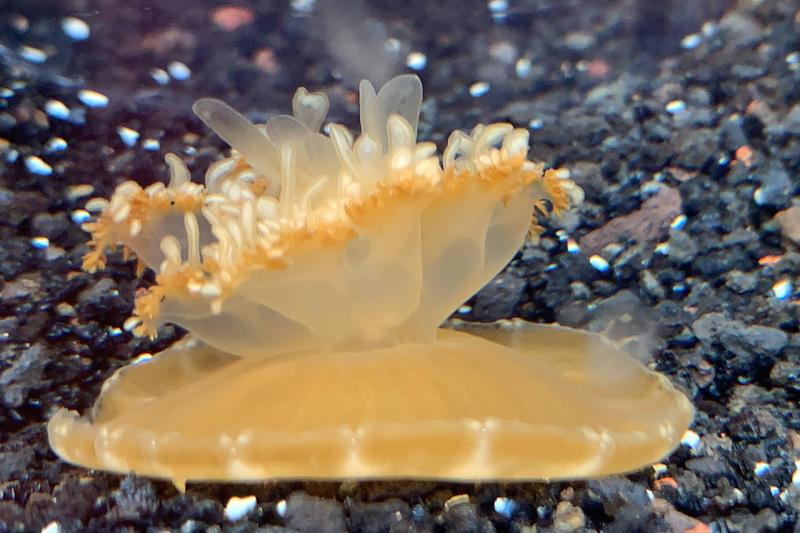A new study shows that the upside-down jellyfish (Cassiopea xamachana) can release small stinging structures in a mucus-like substance—a “stinging snot” if you will. Divers swimming through this mucus may experience an itchy, stinging sensation without ever actually touching the jellyfish, a phenomenon known as “stinging water.”
The Upside-Down Jellyfish
As the name implies, upside-down jellyfish don’t look like your typical jellyfish. They lay on the seafloor with their arms facing up. Most other jellyfish float through the water with their arms and tentacles hanging down. Largely sedentary and often found in large groups, they live in shallow, coastal waters, and are often associated with mangroves.
What Causes “Stinging Water”
When upside-down jellyfish are disturbed from a current, swimmer nearby, or possible predator, they release a mucus-like substance into the water. The stinging nature of the mucus has long been noted by divers. It was explored in publications in 1908, 1936, and 1999 but the cause had never been clearly identified.

Thanks to this team of scientists we now know the mechanism behind stinging water. It rivals that of something dreamed up by the special effects wizards at Disney. It’s a “stinging snot,” and one that packs a powerful punch.
When upside-down jellyfish release mucus it contains microscopic structures called “cassiosomes.” These cassiosomes look like popcorn but function like miniature grenades. Each cassiosome is armed with many harpoon-like structures for stinging and hair like structures for movement. When the mucus is released, the cassiosomes spin through the water. They have the ability to kill prey, sting humans, move in the water, and maintain their structure for up to 10 days.
One of the Fastest Movements in the Animal Kingdom
And that’s not all. The stinging structures may discharge with an acceleration up to 5 million g’s (5 million times the normal pull of gravity). This is more than astronauts experience during a rocket launch (3 g’s) and is one of the fastest known movements in the animal kingdom. Not even Olympic swimming champion Michael Phelps could outswim a sting.

A single release of mucus from one upside-down jellyfish can contain thousands of cassiosomes, each with hundreds of stinging cells. Multiply this by the number of upside-down jellyfish nearby and divers encountering this stinging water could be swimming with millions to billions of cassiosomes and their stinging cells at any given time, especially if many of the jellyfish were disturbed at one time.
Luckily for people, stings are only mildly painful. However, small species that come into contact with the cassiosomes, like brine shrimp, are killed instantly. Interestingly, the venom in these jellyfish is in the same family as venom from the notoriously toxic and sometimes fatal Australian box jellyfish (Chironex fleckeri).
What to Do If You Find Yourself Swimming in Stinging Snot
Now that we know what causes this stinging snot, what do you do if you find yourself coated with it? Dr. Allen Collins is a researcher at the NOAA National Systematics Laboratory and co-author on the paper. He recommends you rinse anything with the mucus on it with vinegar to neutralize any remaining stingers. Avoid rinsing with fresh water as that will cause unfired stingers to discharge and cause further irritation.



